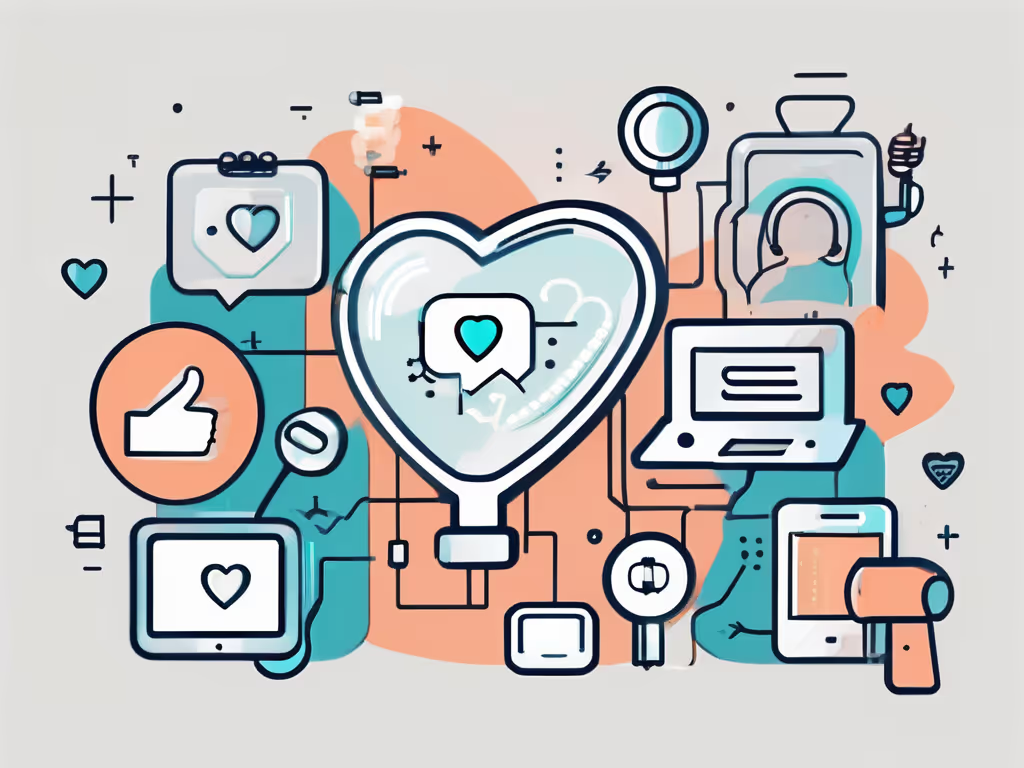Exploring the Top Chatbot Features for Customer Engagement

Chatbots have revolutionized customer engagement, becoming an integral part of businesses' strategies. These AI-powered bots are designed to simulate human conversation, delivering personalized experiences to customers while driving efficiency and scalability. In this article, we delve into the key chatbot features that enhance customer engagement, explore their benefits, examine future trends, and address implementation challenges.
Understanding the Role of Chatbots in Customer Engagement
Over the years, chatbots have evolved from simple rule-based systems to sophisticated virtual assistants capable of understanding natural language and mimicking human behavior. This evolution has been driven by the growing demand for seamless customer interactions and the need for businesses to scale their support operations.

But how exactly did chatbots make this remarkable transformation? Let's take a closer look at the evolution of chatbots in business.
The Evolution of Chatbots in Business
Initially, chatbots were primarily used for information retrieval and basic customer service tasks. They were like digital assistants, providing straightforward answers to common questions. However, as advancements in natural language processing (NLP) and machine learning took hold, chatbots progressed to become intelligent conversational agents.
Nowadays, chatbots are capable of understanding complex queries, recognizing sentiment, and even engaging in witty banter. They have become an integral part of customer engagement strategies, offering personalized experiences and recommendations based on individual preferences.
But what impact do these chatbots have on customer interaction? Let's delve into that next.
The Impact of Chatbots on Customer Interaction
The impact of chatbots on customer interaction is undeniable. A study conducted by Gartner revealed that by 2022, 70% of customer interactions will involve emerging technologies such as chatbots, up from just 15% in 2018. This shift signifies customers' growing acceptance and preference for chatbot interactions.
With chatbots, customers can get immediate assistance and support, regardless of the time of day. They no longer have to wait in long queues or navigate complex phone menus. Instead, they can simply type their query and receive a prompt response, saving them time and frustration.
Furthermore, chatbots have also shown tremendous cost-saving potential for businesses. According to IBM, utilizing a chatbot can reduce customer service costs by up to 30%. The ability to handle basic inquiries and automate repetitive tasks allows human agents to focus on more complex and value-added activities, ultimately improving overall efficiency and productivity.
In conclusion, chatbots have come a long way from their humble beginnings. They have evolved into intelligent conversational agents that enhance customer engagement, provide personalized experiences, and save businesses valuable time and resources. As technology continues to advance, we can expect chatbots to become even more sophisticated, further revolutionizing the way we interact with businesses.
Key Chatbot Features for Effective Customer Engagement
The success of chatbots relies on their features. Let's explore some of the crucial chatbot features that drive effective customer engagement.
Natural Language Processing and its Importance
Natural Language Processing (NLP) is the backbone of chatbot intelligence. It empowers chatbots to understand and respond to customer queries in a conversational manner. By leveraging NLP, chatbots can decipher customer intent, extract meaningful information, and deliver accurate responses.
Advanced NLP techniques, such as sentiment analysis, enable chatbots to gauge customers' emotions and tailor their responses accordingly. This personalized approach enhances customer satisfaction and builds brand loyalty.
For example, imagine a customer reaching out to a chatbot with a complaint about a recent purchase. With NLP, the chatbot can not only understand the issue but also detect the customer's frustration. It can then respond empathetically, offering a solution and ensuring the customer feels heard and understood.
The Power of Personalization in Chatbots
Personalization is a game-changer in customer engagement. Chatbots equipped with customer profiling capabilities can deliver highly tailored experiences based on individual preferences, purchase history, and browsing behavior.
A study by Accenture revealed that 91% of customers are more likely to shop with brands that provide relevant offers and recommendations. By leveraging personalization, chatbots streamline the customer journey, guiding them to the right products or services, and boosting conversion rates.
For instance, imagine a customer visiting an e-commerce website and interacting with a chatbot. Based on the customer's previous purchases and browsing behavior, the chatbot can recommend similar products or offer exclusive discounts, creating a personalized shopping experience that increases the likelihood of a purchase.
The Role of Predictive Analytics in Chatbots
Predictive analytics is another vital feature that empowers chatbots. By leveraging historical customer data, machine learning algorithms embedded within chatbots can predict customer behavior, preferences, and needs.
This predictive capability enables chatbots to proactively offer assistance, recommend products, and address potential issues before they arise. This proactive approach not only enhances customer satisfaction but also drives upselling and cross-selling opportunities.
For example, imagine a chatbot analyzing a customer's past interactions and purchase history. Based on this data, the chatbot can predict that the customer is likely to need a refill of a specific product soon. It can then proactively reach out to the customer, offering a discount on the refill and ensuring a seamless customer experience.
By leveraging the power of NLP, personalization, and predictive analytics, chatbots can revolutionize customer engagement. These features enable chatbots to provide personalized, accurate, and proactive assistance, leading to increased customer satisfaction, loyalty, and ultimately, business success.
The Benefits of Implementing Chatbots
Implementing chatbots yields several benefits for businesses. Let's delve into some key advantages.

One significant advantage of implementing chatbots is the ability to scale customer service operations efficiently. Chatbots act as virtual assistants, providing instant support and resolving customer queries round the clock. By automating repetitive tasks and handling routine inquiries, chatbots free up human agents to focus on more complex issues. This leads to faster response times, increased customer satisfaction, and improved overall service quality.
Moreover, chatbots can be programmed to provide consistent responses based on predefined rules and algorithms. This ensures that customers receive accurate information and assistance every time they interact with the chatbot, enhancing the reliability and credibility of the brand.
Improving Customer Service with Chatbots
Chatbots act as virtual assistants, providing instant support and resolving customer queries round the clock. By automating repetitive tasks and handling routine inquiries, chatbots free up human agents to focus on more complex issues. This leads to faster response times, increased customer satisfaction, and improved overall service quality.
Another key benefit of using chatbots for customer service is their ability to provide personalized assistance. By analyzing customer data and purchase history, chatbots can offer tailored recommendations and solutions, creating a more personalized and engaging experience for users.
Boosting Sales and Marketing Efforts through Chatbots
Chatbots play a pivotal role in boosting sales and marketing efforts. By engaging customers in meaningful conversations, chatbots can capture valuable customer data, identify potential leads, and drive conversions.
For instance, Sephora, a leading cosmetics retailer, leverages a chatbot to provide personalized beauty recommendations. This interactive experience not only enhances customer engagement but also drives product purchases, with the chatbot increasing their average order value by 8%.
In addition to driving sales, chatbots can also assist in lead generation by qualifying leads through interactive conversations. By asking targeted questions and analyzing responses, chatbots can identify high-potential leads and route them to the appropriate sales representatives for further nurturing.
Future Trends in Chatbot Technology
The future of chatbot technology holds exciting prospects. Let's explore a couple of key trends that are set to shape the industry.

The Rise of Voice-Activated Chatbots
Voice-activated chatbots, also known as voice assistants, are gaining popularity. With the rising adoption of devices like Amazon Echo and Google Home, customers are increasingly using voice commands to interact with chatbots.
According to a study by PwC, 32% of consumers prefer using voice commands to control their devices. This trend highlights the need for businesses to develop chatbots that can seamlessly integrate with voice-activated platforms, further enhancing customer engagement.
One of the key advantages of voice-activated chatbots is the hands-free nature of interaction they offer. Users can simply speak their queries or commands, making the process more convenient and intuitive. This technology is revolutionizing the way people interact with devices and is expected to play a significant role in shaping the future of chatbot technology.
AI and Machine Learning: The Future of Chatbots
Artificial Intelligence (AI) and Machine Learning (ML) have already transformed chatbot capabilities. However, the future holds even greater potential, with advancements in deep learning and neural networks.
With these advancements, chatbots will become increasingly sophisticated in their understanding of context, emotions, and complex queries. They will be able to provide more personalized recommendations, engage in deeper conversations, and offer an unparalleled customer experience.
Furthermore, AI-powered chatbots are paving the way for hyper-personalization in customer interactions. By analyzing vast amounts of data in real-time, these chatbots can tailor responses and suggestions to individual preferences, behaviors, and past interactions. This level of customization not only enhances user experience but also drives higher customer satisfaction and loyalty.
Overcoming Challenges in Chatbot Implementation
While the benefits of chatbots are evident, implementation challenges can arise. Let's address some key challenges and strategies for overcoming them.
Addressing Privacy Concerns in Chatbot Use
Privacy concerns are a significant barrier to chatbot adoption. Customers may be hesitant to share sensitive information with chatbots, fearing data breaches or misuse. To overcome this challenge, businesses must ensure robust data security measures and communicate transparently about their privacy policies.
Implementing end-to-end encryption and data anonymization techniques can provide customers with the assurance that their personal information is protected. Additionally, organizations can offer options for customers to control the level of information they share with chatbots, empowering them to make informed decisions.
Ensuring Seamless Integration of Chatbots in Existing Systems
Integrating chatbots with existing systems, such as CRMs or customer databases, can be complex. It is crucial to choose chatbot platforms that offer easy integration capabilities and provide seamless connectivity with different APIs.
Moreover, businesses should involve IT teams from the outset of the implementation process to ensure a smooth integration that aligns with the organization's infrastructure and requirements. Collaborating with IT experts can help identify potential integration challenges early on and develop effective solutions.
Furthermore, organizations can leverage the power of machine learning algorithms to enhance chatbot integration. By analyzing existing data and patterns, machine learning algorithms can identify the most efficient ways to integrate chatbots into existing systems, minimizing disruptions and maximizing productivity.
In conclusion, chatbots have transformed customer engagement by delivering personalized experiences and streamlining support operations. With features such as natural language processing, personalization, and predictive analytics, chatbots have proven their effectiveness in enhancing customer satisfaction and driving business growth.
As the future holds even greater potential with voice-activated chatbots and advancements in AI and machine learning, organizations must understand and embrace these technologies to stay competitive. While challenges may arise during implementation, addressing privacy concerns and ensuring seamless integration of chatbots will pave the way for successful deployment.
By harnessing the power of chatbots, businesses can forge deeper connections with their customers and elevate their customer engagement strategies to new heights. With continuous improvements and advancements in chatbot technology, the possibilities for enhancing customer experiences are limitless.
Take Your Ecommerce to the Next Level with Zipchat AI
Ready to transform your online store's customer engagement and sales? With Zipchat AI, you can leverage the most powerful AI chatbot designed specifically for Ecommerce. Engage with your visitors proactively, boost your conversion rates, and provide exceptional customer support, all while enjoying an average Chat-to-Sale conversion rate of 13.4%. Don't miss out on the opportunity to elevate your business. Start your 7-Day Free Trial today and experience the difference for yourself!
More from our blog
Try Zipchat
For Free








